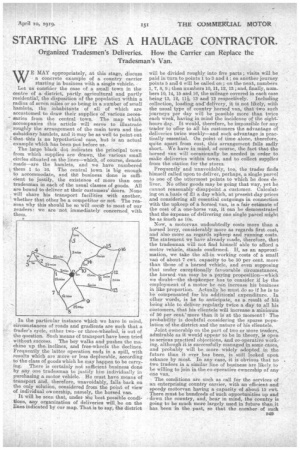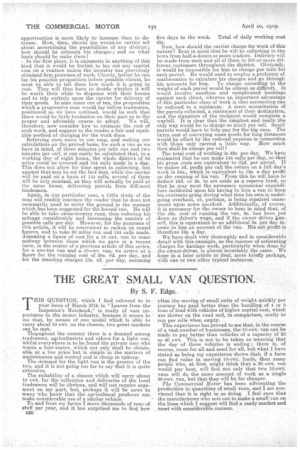STARTING LIFE AS A HAULAGE CONTRACTOR.
Page 19

Page 20

If you've noticed an error in this article please click here to report it so we can fix it.
Organized Tradesmen's Deliveries. •How the Carrier can Replace the Tradesman's Van.
WE MAY appropriately, at this stage, discuss a concrete example of a country carrier starting in business with a single vehicle. Let us consider the case of a small town in the centre of a district, partly agricultural and partly residential, the disposition of the population within a radius of seven miles or so being in a number of small hamlets, the inhabitants of all of which are accustomed to draw their supplies of various neoes Entries from the central town. The map which accompanies this article will serve to illustrate roughly the arrangement of the main town and the ..
subsidia.ri hamlets, and it may be as well to point out -', that this is no hypothetical case, but is an actual example which has been put before us.
The large black dot indicates the principal town from which supplies are drawn, the various small , circles situated on the lines—which, of course, denote roads—are the hamlets, and we have numbered e them 1 to 16. The central town is big enough to accommodate, and the business done is suffi.cient to justify, the existence of more than one tradesman in each of the usual classes of goods. All are bound to deliver at their customers' doors. None . will share his transport facilities with another, ' whether that other be a competitor or not. The reasons why this should be so will cit.ctia to most of our readers: we are not immediately concerned with them.
In the particular instance which we have in mind, circumstances of roads and gradients are such that a trader's cycle, either twoor three-wheeled, is out of the question. Such means of transport have been tried without success. The boy walks and pushes the machine up the. inclines, and free-wheels the declines. Frequently the latter operation ends in a spill, with results which are more or less deplorable, according to the class of goods which he may happen to be carrying. There is certainly not sufficient business done by any one tradesman to justify him individually in purchasing a motor vehicle. He must have means of transport and, therefore, unavoidably, falls back on the only solution, considered from the point of view of individual ownership, namely, the horsed van, It will be seen that, under She best possible conditions, any organization of deliveries will be on the Janes indicated by our map. That is to say, the district will be divided roughly into five parts ; visits will be paid in turn to points 1 to 3 and 4; on another journey points 5 and 6 will be called on ; on the next, numbers 1, 7, 8, 9 ; then numbers 10, 11, 12, 13 ; and, finally, numbers 10, 14, 15 and 16, the mileage covered in each case being 13, 12, 11i, 13 and 13 respectively. Including collection, loading and' delivery, it is not likely, with the usual type of country horsed van, that two such journeys per day will be possible more than twice each week, having in mind the incidence of the eighthours day. It would, therefore, be impossible for any trader to offer to all his customers the advantage of deliveries twice weekly—and such advantage is practically essential. On point of time alone, therefore, quite apart from cost, this arrangement falls sadly short. We have in mind, of course, the fact that the horsed van will occasionally be needed in order to make deliveries within town, and to collect supplieS from the station for the stores.
Frequently and unavoidably, too, the trader finds himself called upon to deliver, perhaps, a single parcel to one of the uttermost points to which he does de liver. No other goods may be going that way, yet he cannot reasonably disappoint a customer. Calculating on a basis of El a day which, at present day prices and considering all essential outgoings in connection with the upkeep of a horsed van, is a fair estimate of the cost of a one-horse van, it can be demonstrated that the expense of delivering one single parcel might be as Much as los.
Now, a motorvan undoubtedly cost more than a horsed lorry, considerably more as regards first cost, and also more as regards upkeep and running costs. The statement we have already made, therefore, that the tradesman will not find himself able to afford a motor vehicle Stands confirmed. If, as an approximation, we tae the all-in working costs of a small van of about 7 evvt. capacity to be 50 per cent. more than those of a horsed vehicle, and even supposing that under exceptionally favourable circumstances, the hersed van may be a paying proposition—which we doubt—the shopkeeper has to consider if lay the employment of a motor he can increase his business in like proportion. Actually he must do so if he is to be compensated for his additional expenditure.. In other words, is he to anticipate, as a result of hiS being able to deliver regularly twice a day to all his customers, that his clientele will increase a minimum of 50 per cent. more than it iS at the moment? The probability is doubtful considering the sparse population of the district and the nature of his clientele.
Joint ownership on the part of two or more traders, admirable as it would appear to be in theory, ila open to serious practical objections, and co-operative working, although itis successfully managed in some cases, and probably will be more widely adopted in the future than it ever has been, is still looked upon askance by most. In any case, it is obvious that no two traders in a similar line of business are likely, to be willing to join in tbe co-operative ownership of any one van.
The conditions are such as call for the services of an enterprising country carrier, with an efficient and speedy motorvan having a capacity of about 15 cwt. There must be hundreds of such opportunities up and down the country, and, bear in mind, the country is going to be much more largely used in future than it has been in the past, so that the number of such Opportunities is more likely to increase than to decrease. How, then, should the would-foe carrier set about ascertaining the .possibilities of any district ; how should he estimate his charges ; and on what basis should he make them2 In the first place, it is axiomatic in anything of this kind that it would be foolish to lay out any capital sum on a venture unless the investor has previously obtained firm promises of work. Clearly, before he can lay his possible proposition before possible clients, he must be able to ten them how much it is going to cost. They wilt then have to decide whether it will be worth their while to dispense with their horses and to rely entirely upon the carrier for delivery of their goods. Iri nine eases out of ten, the proposition which a progressive man would lay before tradesmen, positioned as we have outlined, would be such that there would be little hesitation on their part as to the
proper and • advisable course to adopt. We will, therefore, now consider how to estimate the cost of such work, and suggest to the reader a fair and equit. able method of charging for the work done.
-Referring once more to our map, and making our calculations on the proved basis, for such a van as we have in mind, of three minutes per mile run and two minutes per call, it can easily be calculated that, in a working day of eight hours, the whale district of 64 miles could be covered and 144 calls made in a day. This doesnot allow for time spent in collecting, but against that may be set the fact that, while the carrier will be paid on a basis of 144 calls, several of these will be only nominal, as they will actually be raid at tho same house, delivering parcels from diflcFent tradesmen.
Again, in. our partieular case, a little study of the map will readily convince the reader that he does not necessarily need to cover the ground in the manner which has been suggested for the horsed van. He will be able to take doss-country runs, thus 'reducing his mileage considerably and increasing the number of possible calls per day. However' for the purposes of this article, it will be convenient to reckon on round figures, and to. take 60 miles ranand 144 calls made. Assuming a figure of cost for a le cwt. van to come midway between those which we gave in a recent issue, in the course of a previous article of this series, for a one-ton van and a 10-cwt. van, we arrive at a figure for the running cost of 28s. 8d, per day, and for the standing charges 13s. 4d. per day, assuming
five days to the week. Total of daily working cost 42s.
Now, bow should the carrier charge for work of this nature I Bear in mind that he will be collecting in the town from half-a-dozen or more traders: Delivery will be made from each and all of them to 100 or more different customers throughout the district. Obviously, it would be impossible for him to charge per mile for each pareel. He would need to employ a professor of mathematics to calculate his charges and go through his accounts for him. To charge according to the weight of each parcel would he almost as difficult. It would involve needless and complicated bookings against each client, whereas an important advantage of this particular class of work is that accounting can be reduced to a minimum. A mere enumeration of the parcels collected, a statement of their destination, and the signature of the recipient would complete a waybill. It is clear that the simplest and really, the only way would be to charge so much per call. Small parcels would have to help pay for the big ones. The extra cost of convoying some goods for long distances would be offset by the reduced expense in connection with those only carried a little way. How much then shall he charge per call?
The total cost of working is 42s per day. We have estimated that he can make 144 calls per day, so that his gross costs are equivalent to 31d. per parcel. If he makes Id. profit per call the return on a full day's work is 54s,., which is equivalent to 12s, a day profit on the running of his van. From this he will have te deduct lad. or 2s. to set aside as a reserve fund, so that he may meet the necessary occasional expenditure ineidental upon his having to .hire a van to keep his contracts going during what time his own is undergoing overhaul, or, perhaps, is being repaired consequent upon some accident. Additionally, of course, it is necessary for the owner to bear in mind that, of the 42s. cost of running the van, 9s. has been put down as driver's wage,,and if the owner drives himself, this is equivalent to an additional ns, per day income to him on account of. the van. His net profit is therefore 19s. a day.
We have dealt very thoroughly and in considerable detail with this example, as the manner of estimating charges for haulage work, particularly when done by the owner-driver, is almost invariably the same. We hope in a later article to deal, more briefly perhaps, with one or two other typical instances.






















